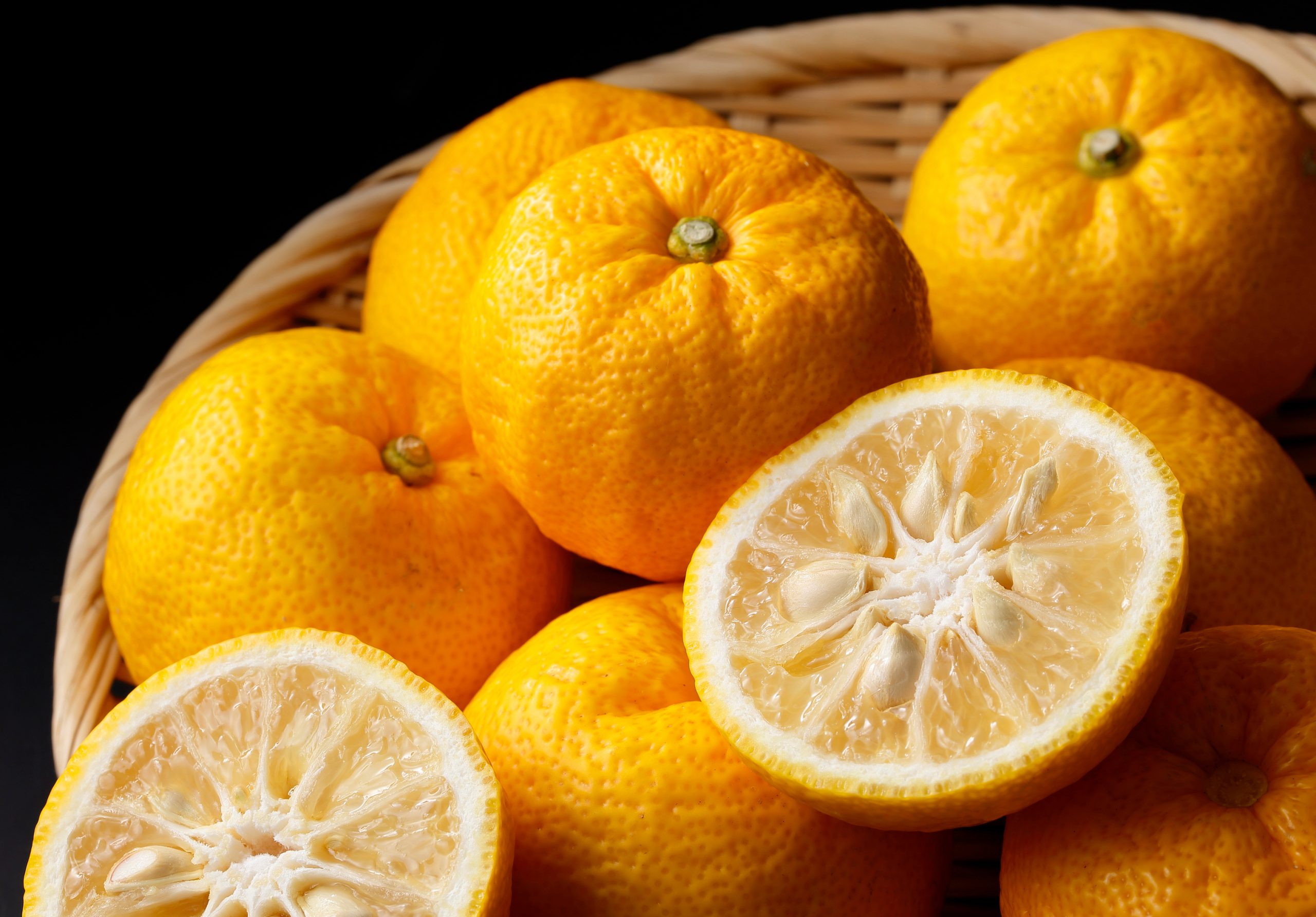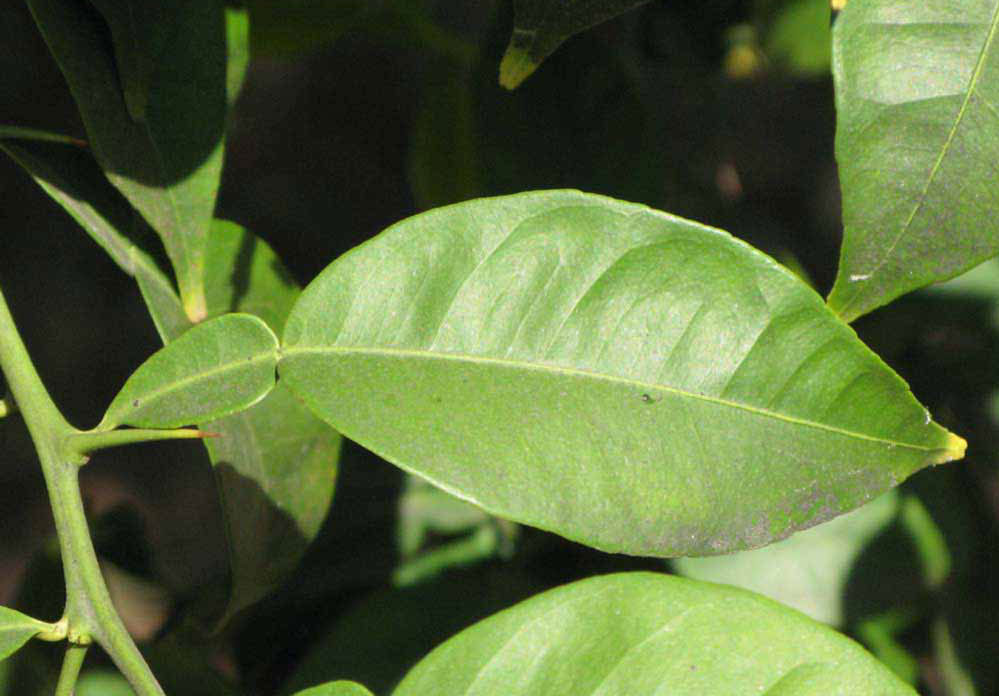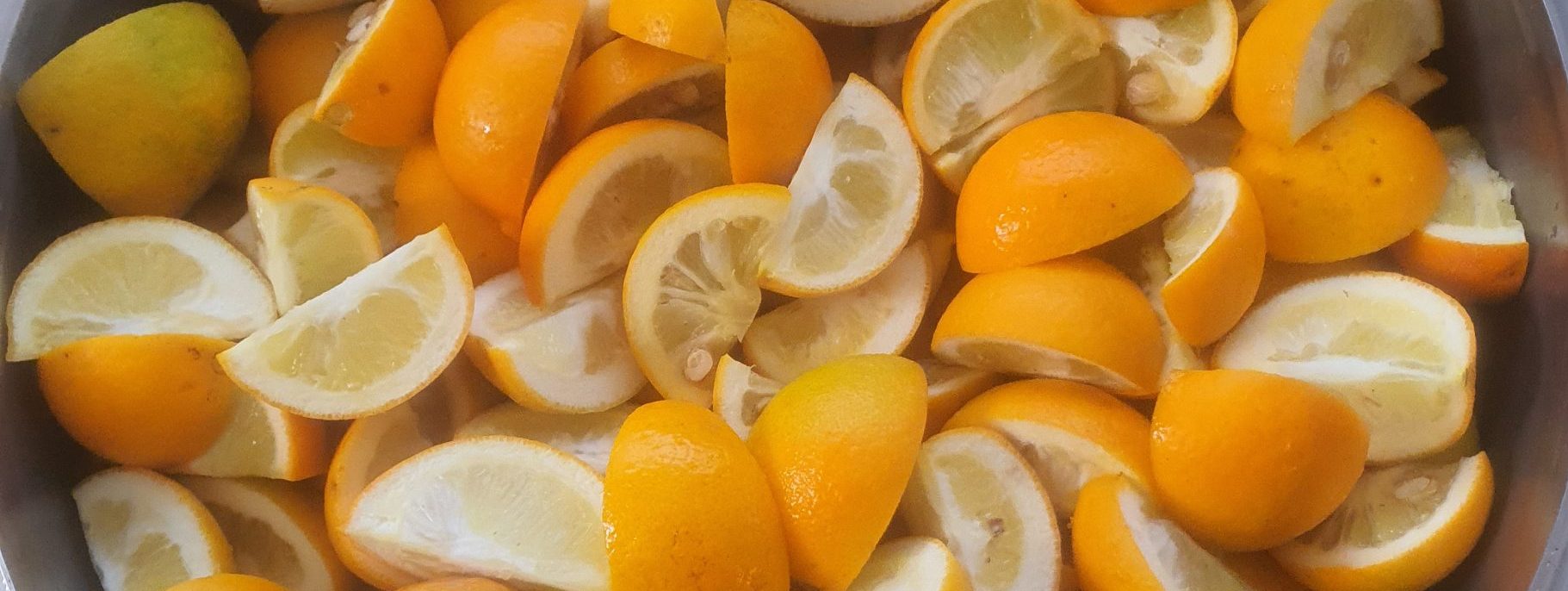Citrus junos
ENCYCLOPEDIA BOTANICA / YUZU
Yuzu's unique fragrance is beautiful and aromatically complex, combining many familiar citrus tones—lime, mandarin, lemon—with an underlying herbal freshness and spice. Both the aromatic peel and highly acidic juice are used extensively in Japanese and Korean cooking.
Description & Habitat
Also known as the Japanese citron, yuzu (Citrus junos) is a winter-ripening citrus with a rich acidity and distinctive fragrance. C. junos is believed to be a hybrid of the wild ichang papeda (C. ichangensis) and a mandarin (C. reticula var austere). This mandarin is a common ancestor of many of our modern citrus, and was smaller, seedier and more acidic than the ones we know today.
Yuzu’s origins have been traced back to China, where it was discovered growing along the banks of the Yangtze river, though today it’s most strongly associated with Japan and Korea, where the trees flourish. Probably the hardiest citrus variety, it’s cold-hardy down to -10C and is often used as a rootstock for satsuma mandarins and other citrus. It’s a spiny, wild tree with an upright nature and dense foliage made up of smallish leaves. These leaves have a winged petiole (stem)—similar but smaller than those on the leaf of the makrut or kaffir lime (C. hystrix), where the petiole is so large the leaves look double-lobed.
Fruit is round and slightly flattened at the poles (about the size and shape of a tangerine) but with a rougher, more pebbly rind. Yuzu has many large seeds and usually ripens from green to yellow, and sometimes orange (there are many variations and hybrids, all with subtle flavour variations).
Parts used: peel, juice, whole fruit.

The fruit typically has a pebbled skin, thick pith and many large seeds

Yuzu leaf with winged petiole
Aroma & Flavour Profile
One of the most complex of the citrus fruits, yuzu is a great harmonizer. Its fragrant peel has many different facets—floral, fruity and spicy, with a pared-back citrus freshness—meaning it can add layers and create links in aromatic blends.
It has been variously described as having notes of lime, green mandarin, grapefruit, stone fruit, mango, spice, green-herbal, pine and jasmine blossom. But as Niki Segnit (author of The Flavour Thesaurus) notes ‘comparisons are difficult, because it has a perfume all of its own’. Or as The Alembic’s Lab’s Jill Mulvaney puts it ‘defining yuzu is like going down a rabbit hole’. A very enjoyable one though, and great for experimentation.
The fruit’s delightfully multifaceted aroma may account for this large range of comparisons, but as we’ve already mentioned, there are many variations and hybrids, all with subtle aromatic variations. The Alembics Lab’s local trees ripen to orange, and the zest is highly perfumed, carrying significant tropical fruit and floral tones with an underlying spicy funk.
When you delve into the main constituents of its essential oil you find it’s limonene-led, like all citrus, but has a range of other significant constituents that hint at its complexity such as linalool (floral-herbal-woody), y-terpinene (green-herbal) b-myrcene and a-pinene (green-spice-pine).
As for the juice, it’s highly acidic, and (like the zest) it intensifies other flavours—such as miso, mushrooms, custards, and when mixed with other citrus it can boost their qualities also.
Taken as a whole the fruit is a wonderful balance between sweet perfume and citrus freshness—as Jill Mulvaney explains ‘it’s when you cut it open and smell the whole fruit that it shines in harmony. The rich and intoxicating aroma of the zest is beautifully balanced by the light, juicy, tart, familiar citrus notes of the flesh’.

Recommended techniques
• Hydro distillation (hydrosol) • Steam distillation (EO) • Spirit distillation (gin, aromatic spirits, liqueurs) • Tincture • Cold-pressed (EO) • Fixed oil infusion • Simple infusions • Cooking •
Uses
Culinary
Yuzu plays an essential supporting role in both Japanese and Korean cuisine—the perfumed rind is used in soups, sauces, marinades, with fish, candies and teas. It is the base of many iconic Japanese foods like miso and ponzu sauce, and is a key ingredient in the Korean chilli paste gochujang. The fruit evokes strong winter-time connections in Japan, where its juice is used in the place of vinegars in cooking and sauces, and the rind is regularly sprinkled over food for an aromatic kick. Described as one of those versatile seasonings, each family has their own yuzu recipes.
In recent years yuzu’s popularity has spread far beyond Asia, and it’s used in restaurants and home kitchens around the world. The next time you come across some of this citrus, try this easy and delicious recipe for yuzu vinegar. Mixing the juice with honey and sugar then simmering will yield a delicious yuzu syrup for cocktails or to use as a mixer. It also makes a pretty impressive marmalade.
Teas and infusions
In Japan yuzu hachimitsu (a combination of yuzu and honey) is used to make yuzu tea. The zest is great in herbal infusions, where it can be used in place of other citrus, or added on top to heighten the effect (we especially like it with ginger). Yuzu is also regularly added into black, green and matcha teas, where it works beautifully with these different blends.
Spirits
Yuzu has long been used to make wine and aromatic spirits. It makes a stunning addition to flavoured sake and the shochu-based liqueur yuzukomachi. The Drunken Botanist also recommends a Korean yuzu syrup called yucheong (usually mixed with hot water to make tea) as a good cocktail ingredient. Or try our herbal citrus sherbet recipe that can be used as a base for zero ABV drinks as well as alcoholic cocktails.
It’s also a brilliant gin botanical. You can see from the breakdown of the major aromatic ingredients (see the EO section) there is a big flavour overlap with so many classic gin botanicals—coriander seeds especially—but also juniper and angelica, not to mention it’s affinity for other citrus. It’s a core ingredient in the popular Japanese Roku gin, and is finding its way into many commercial gin blends. Yuzu is also increasingly popular with brewers, New Zealand’s Garage Project use green yuzu from local growers to brew their seasonal beer "Yuzukosho".
Essential oil
Yuzu essential oil can either be cold-pressed or distilled, and at The Alembics Lab, we extract our EO by cutting up the whole fruit and steam distilling. Like other citrus oils it’s prone to oxidation, so it’s best stored away from light and in the fridge. Yuzu’s use in aromatherapy is relatively recent, so little research has been done into its effects, but it’s widely reported as uplifting. And according to research done by the fragrance and taste company Firmenich ginger and yuzu are the scents people most associated with happiness.
As with all citrus, yuzu EO’s main component is limonene (around 60%), but it has several other components present in significant levels that account for its difference and complexity. There’s y-terpinene (also present in lemon and lime) which gives a green, herbal note. Linalool, also present in coriander, thyme, and orange blossom water is responsible for the floral-herbal-woody notes. B-myrcene (present in rosemary, pink peppercorns, juniper, pine, and celery leaf) give green-pine-spice. And the spruce-pine of a-pinene that is also present in juniper, angelica root, rosemary, coriander seed.
Hydrosol
Yuzu hydrosol is fresh, sweetly-perfumed and delightful. It’s also a great way to use up a lot of peeled fruit you may have left over after you’ve removed the zesty peel to dry for other uses. We place the peeled fruit into the pot of our still, cover with water and hydro distil. We use this hydrosol in skin care, tonics and drinks.
Perfumery
Very popular amongst fragrance houses in recent years, some use yuzu as a top note, or often it’s taken as a muse and re-interpreted as an accord (often broken down into lime, green mandarin and jasmine-like floral notes). L’Eau d’Issey Pour Homme Yuzu by Issey Miyake and Jo Malone Yuzu Zest Cologne are two such examples. We use our yuzu EO in perfume accords, as it really does harmonise so well with such a range of other scents. It’s also great for amplifying other citrus notes when it’s layered on top of citrus blends.
Skin care and cosmetics
You will find yuzu in many soaps, personal care products and detergents. We like to use both the hydrosol and the EO in our natural skin care formulations—one such example is our yuzu body balm, which uses a combination of these aromatic products to layer yuzu aroma.


